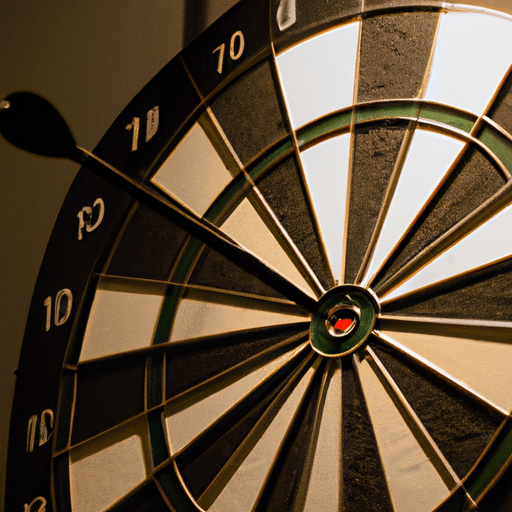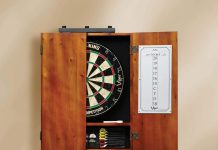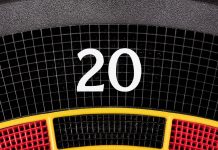When it comes to hanging a dartboard, there’s one question that always seems to arise: what is the best height? Finding that perfect sweet spot can make all the difference in the world for avid dart players, and in this article, we’ll explore the key factors that determine the optimal height for a dartboard. So whether you’re a seasoned pro or just getting started with this timeless game, read on to discover the secret to hitting the bullseye every time.
Review contents
Factors to Consider
When it comes to hanging a dartboard, there are several factors to consider to ensure you have the best dartboard setup for your needs. These factors include dartboard regulations, player height and skill level, playing space, lighting, and safety. By taking these factors into account, you can create an ideal dartboard setup that promotes accuracy, comfort, and enjoyment.
Dartboard Regulations
Before you hang a dartboard, it’s important to be aware of the standard regulations governing its placement. While these regulations may vary slightly depending on the country or league, they typically provide guidelines to ensure fair play and consistency in dart games. Familiarizing yourself with these regulations will allow you to set up your dartboard in compliance with the standards.
Standard Regulations
One of the key aspects of dartboard regulations is the height at which the board should be hung. According to the World Darts Federation (WDF), the bullseye of the dartboard should measure 5 feet 8 inches (173 cm) from the floor. This standard regulation height ensures that players have a consistent target to aim at, regardless of their height or skill level.
Professional Standards
For those aspiring to play darts at a professional level, it’s essential to adhere to professional standards. Professional darts organizations, such as the Professional Darts Corporation (PDC), often have their own specific regulations regarding dartboard height and other aspects of the game. Aspiring professional players should consult the guidelines set by these organizations to ensure they are practicing and competing at the highest standards.
Variations by Country/League
It’s worth noting that dartboard regulations may vary slightly depending on the country or league in which you are playing. Different organizations may have their own specific rules regarding dartboard height and other factors. Before setting up your dartboard, it’s important to check the regulations specific to your country or league to ensure you are in compliance.
Player Height and Skill Level
Player height and skill level are important factors to consider when determining the optimal height at which to hang a dartboard. Ensuring that the dartboard is at the right height for the player can greatly enhance their comfort and accuracy.
Ergonomics and Comfort
Ergonomics play a vital role in creating a comfortable and efficient dartboard setup. Taller players may benefit from a slightly higher dartboard height, as it allows them to maintain a natural throwing posture without straining their arm or shoulder. Conversely, shorter players may prefer a slightly lower dartboard height to ensure they can comfortably throw without having to overreach.
Beginners and Recreational Players
For beginners and recreational players, finding the right dartboard height is essential to establishing good throwing mechanics and fostering improvement. It’s recommended that beginners start with the standard regulation height and make adjustments based on their comfort and performance. Experimentation and practice will help beginners find their optimal dartboard height as they develop their own throwing style.
Experienced and Professional Players
Experienced and professional players often have their own preferred dartboard height based on their individual playing styles and preferences. Some players may prefer a higher dartboard height for a more aggressive throwing technique, while others may prefer a lower height for a more controlled and accurate throw. The key is to find a height that allows the player to consistently hit their desired targets and maximize their performance.
Playing Space
The playing space surrounding the dartboard is another crucial element to consider when setting up your dartboard. The layout of the playing space can impact the player’s ability to move freely and throw with confidence.
Wall vs. Cabinet Mounting
The first decision to make is whether to mount the dartboard on the wall or in a cabinet. Wall mounting is the traditional and most common method, allowing for a clear line of sight to the dartboard. Cabinet mounting, on the other hand, provides a more compact and aesthetically pleasing solution, with the added benefit of protecting the wall from stray darts.
Room Size
The size of the room where you plan to hang your dartboard is an important consideration. A larger room allows for more freedom of movement, especially for players who like to step back from the throwing line before releasing their darts. If space is limited, players may need to adjust their throwing technique or consider alternative dartboard setups, such as a smaller-sized dartboard or a standing dartboard.
Distance Behind the Throwing Line
The distance between the throwing line and the wall or cabinet where the dartboard is mounted is also crucial. The standard distance is 7 feet 9 and 1/4 inches (237 cm), known as the “oche” or “throwing line.” This distance allows players to have sufficient room for their throwing motion while maintaining a comfortable distance from the dartboard. It’s important to ensure that there are no obstructions or obstacles behind the throwing line that may interfere with the player’s movement.
Obstacles and Interferences
When determining the playing space for your dartboard, it’s essential to consider any potential obstacles or interferences that may affect gameplay. Ensure that there are no objects, such as furniture or decorative items, within the immediate vicinity of the dartboard that could obstruct the player’s throwing path or interfere with the trajectory of the darts. Clearance around the dartboard is essential to promote smooth and unimpeded gameplay.
Lighting
Proper lighting is crucial for creating an optimal playing environment and ensuring clear visibility of the dartboard. Adequate lighting helps players accurately aim and target their throws, reducing the risk of missed shots and improving overall gameplay.
Shadow-Free Illumination
To eliminate shadows on the dartboard, it’s important to choose lighting fixtures that provide even and uniform illumination. Overhead lighting, such as a ceiling-mounted fixture or track lighting, is often the most effective way to achieve shadow-free illumination. Additionally, positioning the light source directly above the dartboard helps minimize shadows cast by the darts themselves.
Gentle Illumination
While it’s essential to have sufficient lighting, it’s equally important to ensure that the illumination is not too harsh or glaring. Gentle, diffuse lighting is preferable, as it reduces eye strain and creates a more comfortable playing environment. Avoid using bright and direct lighting sources, such as spotlights or fluorescent lights, as these can create excessive glare and hinder visibility.
Avoiding Glare and Reflections
Glare and reflections can be distracting and obstructive during a game of darts. To minimize glare, position the dartboard away from windows or other light sources that may cause reflections on the board’s surface. If glare persists, consider using anti-glare coatings on the dartboard or installing shades or curtains to control the amount of incoming light.
Safety
Safety should always be a top priority when setting up a dartboard. By taking necessary precautions, you can protect both the walls and surrounding area from damage and prevent injuries caused by errant darts.
Protecting Walls and Surrounding Area
To safeguard the walls from dart impacts, it’s advisable to mount the dartboard on a sturdy backing board or protective surround. This protects the wall surface from potential punctures and damage caused by missed darts. Additionally, placing a durable mat or carpet beneath the dartboard can help prevent damage to the floor in case of dropped or ricocheting darts.
Avoiding Injury
Darts can be dangerous if not handled and played responsibly. To minimize the risk of injury, it’s important to establish clear rules and guidelines for safe dart play. Emphasize the importance of proper throwing technique, avoiding distractions during gameplay, and ensuring that spectators and other players maintain a safe distance from the throwing area.
Securing the Dartboard
Properly securing the dartboard to the wall or cabinet is vital to prevent accidents caused by a loose or unstable board. Ensure that the dartboard is securely mounted, with no movement or wobbling when the darts hit the board. This prevents the dartboard from shifting or falling during gameplay, reducing the risk of potential injuries.
Methods for Determining Height
Determining the ideal height at which to hang a dartboard can be done using various methods, each with its own merits. Consider these methods when deciding on the optimal dartboard height for your specific needs.
Standard Regulation Height
The standard regulation height of a dartboard is 5 feet 8 inches (173 cm) from the floor to the bullseye. This is the height recommended by professional darts organizations and provides a consistent playing experience for players of all heights and skill levels. Hanging the dartboard at this height ensures adherence to the standard guidelines and promotes fair and competitive gameplay.
Targeting the Bullseye
Another method for determining dartboard height is to target the bullseye. Stand at the throwing line and visualize your eye level aligning with the bullseye. Adjust the height of the dartboard until the bullseye is at your eye level. This method ensures that the dartboard is positioned according to your individual height and eye position, providing a personalized experience.
Hanging Based on Player Height
If you prefer a more customized approach, you can determine the dartboard height based on your height. Start by measuring your height from the floor to the center of your closed fist. Subtract the length of your forearm to determine the recommended height at which to hang the bullseye. This method takes into account your individual arm and throwing motion, providing a height that suits your unique physical attributes.
Adjusting the Height for Different Players
If multiple players of varying heights will be using the dartboard, it may be necessary to adjust the height to accommodate everyone. One approach is to hang the dartboard at the standard regulation height and allow players to stand at different distances from the throwing line to compensate for their height differences. Alternatively, you can experiment with different dartboard heights to find a middle ground that suits all players.
Tips for Finding the Right Height
Finding the right dartboard height can be a personal preference, and there is no one-size-fits-all solution. Here are some helpful tips for determining the optimal height that works for you and your fellow players.
Consulting Official Guidelines
When in doubt, consult the official guidelines provided by professional darts organizations or the regulations specific to your country or league. These guidelines offer a solid foundation and ensure that your setup meets industry standards.
Considering Personal Preference
Personal preference plays a significant role in finding the right dartboard height. Experiment with different heights to determine the one that feels most comfortable and natural to you. Take note of your throwing motion, arm position, and overall comfort level when adjusting the dartboard height.
Experimenting and Adjusting
Don’t be afraid to experiment and make adjustments to the dartboard height. Try different heights during practice sessions to see which height allows you to consistently hit your desired targets. Take note of any improvements in accuracy and comfort as you make adjustments.
Seeking Advice from Experienced Players
Experienced players can provide valuable insights and advice when it comes to finding the best dartboard height. Seek guidance from experienced players who have already gone through the process of finding their ideal dartboard setup. They may be able to offer tips and suggestions based on their personal experiences.
Common Dartboard Heights
While the standard regulation height of 5 feet 8 inches (173 cm) is most commonly used, there are certain deviations based on different scenarios, preferences, and leagues.
Standard/Regulation Height
The standard regulation height of 5 feet 8 inches (173 cm) remains the most widely recognized and used height in professional darts competitions. This height ensures consistency and fairness across different tournaments and leagues.
Home and Recreational Height
In home and recreational settings, dartboard heights may vary depending on personal preferences and available space. Many recreational players often opt for a slightly lower height to accommodate a more relaxed and casual playing style. Heights ranging from 5 feet 6 inches (167 cm) to 5 feet 7 inches (170 cm) are commonly chosen for home setups.
Common Heights by Country/League
Different countries and leagues may have their own specific dartboard height regulations. For example, in England, the standard height is 5 feet 8 inches (173 cm), while in the United States, the American Dart Organization (ADO) sets the height at 5 feet 6 inches (168 cm). It’s important to consult the regulations and guidelines specific to your location or league to ensure compliance.
Conclusion
Finding the best height to hang a dartboard is a balancing act that involves considering multiple factors. By taking into account dartboard regulations, player height and skill level, playing space, lighting, and safety, you can create an optimal dartboard setup that promotes accuracy, comfort, and a positive playing experience. Experimentation and adjustment are key in finding the right height that suits your individual needs, but it’s important to also consider standard regulations and seek advice from experienced players. Remember, finding the perfect dartboard height is a combination of guidelines, personal preference, and a pinch of trial and error. So, go ahead, hang that dartboard, and start aiming for that bullseye!























![Best Outdoor Dartboards [Reviews and Buying Guide 2024] Best Outdoor Dartboards](https://gamersets.com/wp-content/uploads/2022/12/Best-Outdoor-Dartboards-100x70.jpg)

![Best Mini Air Hockey Table [Reviews & Buying Guide 2024] Best mini air hockey table](https://gamersets.com/wp-content/uploads/2022/10/Best-mini-air-hockey-table-100x70.jpg)







